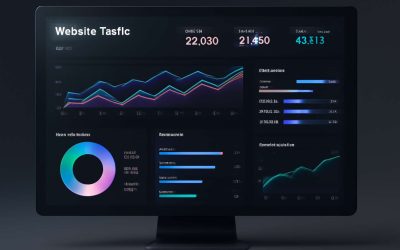Understanding Website Traffic Analytics
Defining Website Traffic Analytics – What is website traffic analytics and its importance
In a digital landscape where every click whispers a story, understanding the intricacies of analytics for website traffic becomes paramount. Nearly 60% of online experiences are driven by data—yet many overlook the profound insights lurking within those metrics. Website traffic analytics isn’t merely about counting visitors; it’s about deciphering patterns, behaviours, and preferences that reveal the soul of your digital presence. It’s akin to holding a mirror up to your audience, allowing you to glimpse their motivations and anticipate their needs.
Defining analytics for website traffic involves more than tracking page views; it encompasses a comprehensive examination of user interactions, sources of traffic, and engagement levels. By analysing this data, businesses can optimise their content, enhance user experience, and ultimately, forge stronger digital relationships. For a deeper understanding, consider these core components:
- Visitor demographics and behaviour patterns
- Traffic sources and referral pathways
- Conversion rates and engagement metrics
Harnessing the full potential of analytics for website traffic transforms raw numbers into powerful narratives—stories that drive strategic decisions and foster meaningful growth. It’s a journey into the psyche of your web audience, revealing what truly resonates beneath the surface. When you dive into these analytics, you gain a vantage point that’s both enlightening and essential for navigating the ever-evolving digital realm.
Key Metrics to Track – Visits, page views, bounce rate, session duration, and more
Understanding website traffic analytics hinges on more than just tallying visits. The real power lies in deciphering key metrics that reveal the behaviour of your audience and the effectiveness of your digital strategy.
Visits and page views are the foundational indicators, but they only scratch the surface. Bounce rate, for instance, exposes how many visitors leave after viewing just one page—an ominous sign if it’s high. On the other hand, session duration offers insight into how long users engage with your content, hinting at its relevance and appeal.
- Traffic sources help identify where your visitors come from—whether through organic search, social media, or referral links—each revealing different layers of your outreach.
- Conversion rates indicate how well your website persuades visitors to take desired actions, serving as the ultimate measure of success.
By tracking these metrics, analytics for website traffic transforms raw data into a narrative of your digital influence, guiding you to refine your approach with precision.
Why Monitoring Traffic Analytics Matters – Business insights, optimization, and growth opportunities
In the vast digital landscape, where every click weaves a story, understanding analytics for website traffic becomes an essential compass guiding your voyage. It’s not merely about counting visitors but unraveling the intricate dance of behaviour, intent, and engagement that fuels your online presence. As the saying goes, “what gets measured, gets managed”—and in this realm, metrics are the silent architects of success.
Monitoring traffic analytics reveals the hidden currents shaping your digital influence. It exposes patterns—peaks of interest and valleys of disinterest—allowing you to refine your strategy with surgical precision. By examining the ebb and flow of visitor interactions, you unlock opportunities for optimisation and growth. When you truly grasp the power of analytics for website traffic, each data point transforms into a narrative, whispering secrets about your audience’s desires and your website’s potential.
Tools and Software for Website Traffic Analysis
Popular Analytics Platforms – Google Analytics, Matomo, Adobe Analytics, and others
In the intricate dance of digital presence, selecting the right tools for analytics for website traffic can feel like navigating a labyrinth. The digital landscape offers a plethora of platforms, each with its unique strengths and philosophies. Google Analytics remains the stalwart, providing comprehensive insights that illuminate user behaviour and engagement patterns. Its real-time data and custom reporting capabilities make it an invaluable resource in understanding how visitors interact with your site.
Meanwhile, open-source alternatives like Matomo champion privacy and flexibility, allowing organisations to retain full control over their data. For enterprises seeking more sophisticated, customisable solutions, Adobe Analytics offers an extensive suite of features that delve deep into user segmentation and predictive analytics.
Among these tools, a curated selection often includes features such as event tracking, conversion funnels, and behavioural analysis, all vital in decoding the complex tapestry of visitors’ journeys. Engaging with these platforms transforms raw data into a narrative—one that reveals not just who your audience is, but how they experience your digital environment.
Features to Consider – Real-time data, segmentation, conversion tracking, and custom reports
In the complex realm of analytics for website traffic, choosing the right tools can feel like navigating a labyrinth of possibilities. The core features to consider—such as real-time data, segmentation, conversion tracking, and custom reports—are vital in transforming raw numbers into meaningful narratives. Real-time data, for instance, offers immediate insights into visitor behaviour, enabling swift adjustments and optimisations that can significantly impact engagement.

Segmentation allows you to slice and dice your audience, revealing nuanced patterns that might otherwise stay hidden. Conversion tracking provides clarity on how visitors move through your site, highlighting bottlenecks or opportunities for improvement. Custom reports, meanwhile, empower organisations to tailor their analytics for website traffic, ensuring that data aligns precisely with strategic objectives.
- Event tracking to monitor specific user interactions
- Funnel analysis to understand the customer journey
- Behavioural analysis to identify user preferences
These features collectively enhance your ability to decode visitor journeys and optimise digital experiences effectively.
Integrating Analytics Tools with Your Website – Setting up tracking codes and ensuring data accuracy
Integrating analytics for website traffic is more than just embedding a tracking code; it’s about forging a connection between human curiosity and digital behaviour. Setting up these tools requires precision and an understanding that every line of code acts as a silent observer, capturing the subtle rhythms of your visitors’ journey. Ensuring data accuracy is paramount—missed or skewed data can distort insights and lead to misguided decisions.
To achieve this, meticulous implementation involves verifying that tracking pixels or scripts are correctly placed across all pages, and that they do not interfere with user experience. Consider adopting a layered approach: start with a primary analytics platform, then customise it with additional event tracking and filters.
- Utilise tag management systems for seamless updates
- Regularly audit your tracking setup to prevent data drift
- Align your analytics setup with your overarching strategic goals
In the labyrinth of analytics for website traffic, this disciplined setup becomes the compass that guides you through the complex maze of digital insights, revealing truths that can transform your online presence into a resonant force.
Analyzing Website Traffic Data Effectively
Interpreting User Behavior – Understanding how visitors interact with your site
Understanding user behaviour is the secret to unlocking your website’s true potential. When you delve into analytics for website traffic, you uncover patterns that can seem almost supernatural—mysterious, yet revealing. Visitors who linger longer might be genuinely interested, while those who bounce away at lightning speed reveal gaps in your content or user experience. By examining how users navigate through your site, you gain a window into their intentions and preferences.
This level of insight is crucial. It’s not just about numbers; it’s about interpreting those numbers to craft a story—one that highlights where your site captivates and where it loses interest. With real-time data and segmentation, you can track visitor journeys and identify the exact moments where engagement falters. It’s as if your website whispers secrets—if you know how to listen carefully, you can anticipate user needs and refine your strategy accordingly. Harnessing analytics for website traffic transforms raw data into a powerful narrative, guiding you toward optimisation and growth.
Segmenting Traffic Sources – Organic, paid, direct, referral, social
Understanding where your website traffic originates isn’t just a matter of curiosity—it’s the secret sauce for targeted growth. When you start analysing website traffic data, you quickly realise that not all visitors are created equal. Organic traffic from search engines, paid campaigns, direct visits, referrals, and social media each tell a different story about your audience’s behaviour. Effective segmentation of these traffic sources allows you to tailor your marketing efforts and optimise user engagement.

Consider this: a large chunk of your traffic might come from social media, but if those visitors bounce quickly, it signals your content isn’t resonating. Conversely, organic visitors sticking around might mean your SEO game is on point. To really harness this insight, use analytics for website traffic to categorise your data into
- Organic
- Paid
- Direct
- Referral
- Social
segments. This approach transforms raw numbers into actionable intelligence, helping you identify which channels deserve your attention and which need a rethink. By dissecting traffic sources, you turn analytics into a strategic compass—guiding your website’s evolution with precision and flair.
Conversion Funnels and Goal Tracking – Measuring conversions and user journeys
Effective analysis of website traffic hinges on understanding user journeys through conversion funnels and goal tracking. By mapping out the steps visitors take—from landing on your homepage to completing a purchase or signing up—you can pinpoint exactly where users drop off. This insight allows you to optimise each stage, transforming a casual browser into a loyal customer.
Utilising analytics for website traffic to monitor conversion rates helps evaluate whether your marketing strategies are paying off. For example, setting up goal tracking in your analytics platform reveals which channels drive the most valuable actions. Consider implementing a step-by-step approach:
- Identify key conversion points within your website.
- Set up specific goals in your analytics platform.
- Analyse user flow to see where visitors abandon their journey.
This method turns raw data into a strategic blueprint, giving you a clearer picture of user behaviour and where to focus your optimisation efforts. When you understand the intricacies of your conversion funnels, you’re better equipped to fine-tune your website’s performance and elevate overall engagement.
Optimizing Your Website Based on Analytics Insights
Improving User Experience – Navigation, layout, and content adjustments
Harnessing the power of analytics for website traffic can transform a cluttered digital space into a seamless user experience that keeps visitors coming back. When you interpret user behaviour through these insights, you uncover how visitors navigate your site, revealing friction points and opportunities for enhancement. Improving user experience isn’t just about aesthetic appeal; it’s about crafting an intuitive journey that guides users effortlessly from landing to conversion.
Adjustments to navigation, layout, and content can make all the difference. For example, simplifying menus or repositioning key information based on analytics data can dramatically reduce bounce rates and increase engagement. Consider prioritising features like clear calls-to-action or relevant content that resonates with your audience. A well-informed redesign grounded in analytics for website traffic ensures every element serves a purpose, creating a more satisfying and effective user experience.
- Analyse heatmaps and click patterns to identify the most engaging areas of your site.
- Refine layout and content placement to guide visitors more intuitively.
- Test different navigation structures to see which yields the best user retention.
Enhancing Content Strategy – Identifying popular content and gaps
In the intricate dance of digital presence, understanding which content resonates most deeply can transform your website from a mere online placeholder into a dynamic hub of engagement. Analytics for website traffic reveal not just what visitors seek, but also the silent gaps waiting to be filled. By examining metrics such as page views and user flow, you uncover the stories behind your most popular content and identify opportunities for expansion or refinement.
Harnessing these insights allows you to craft a content strategy that aligns precisely with audience preferences. For example, if analytics indicate a surge of interest in a particular topic, dedicating more resources there makes strategic sense. Conversely, recognising underperforming pages provides a chance to reimagine their purpose or merge them with more compelling material. Incorporating these insights into your content development process ensures every piece serves a meaningful role in captivating your audience, elevating your website’s allure and authority.
Increasing Conversion Rates – A/B testing and targeted calls-to-action
In the bustling digital marketplace, every click, scroll, and pause tells a story—if you know how to listen. Harnessing analytics for website traffic reveals not only what captures your visitors’ attention but also uncovers subtle signals that guide your optimisation efforts. One powerful approach is to leverage A/B testing, where two versions of a webpage are compared to see which performs better. This method allows you to fine-tune your calls-to-action, making them more compelling and tailored to your audience’s preferences.
Targeted calls-to-action, when informed by analytics for website traffic, can significantly boost conversion rates. By analysing user behaviour, you can identify which elements encourage engagement or cause drop-offs. Implementing split tests on different headlines, button placements, or colours provides insight into what truly resonates. For instance, a simple variation in wording might lead to a noticeable increase in sign-ups or sales. Embracing these insights transforms your website into a finely tuned machine that converts visitors into loyal customers.
Advanced Techniques in Website Traffic Analytics
Utilizing Heatmaps and Session Recordings – Visualizing user interactions
Unlocking the secrets behind user behaviour on your website can feel like deciphering an ancient manuscript—until advanced techniques in analytics for website traffic come into play. Heatmaps and session recordings are the unseen lenses that reveal exactly how visitors interact with your content, transforming raw data into compelling stories. They offer a visual tapestry of clicks, scrolls, and hovers, illuminating areas that captivate or confuse users.
Imagine observing a visitor’s journey in real-time, witnessing moments of hesitation or delight that static metrics simply cannot convey. Heatmaps provide a colour-coded map, highlighting hotspots of activity, while session recordings allow you to replay user sessions with astonishing clarity. These tools enable a deeper understanding of user interactions, enabling businesses to optimise website design and content strategy effectively.
- Identify friction points where visitors drop off or linger.
- Discover which elements drive conversions and which are ignored.
- Refine user experience by visualising actual behaviour patterns.
Implementing Event Tracking – Monitoring specific actions like clicks and downloads
In the labyrinthine realm of analytics for website traffic, the ability to monitor specific actions—such as clicks, downloads, or form submissions—elevates understanding from mere surface impressions to profound behavioural insights. Implementing event tracking transforms the opaque into the transparent, revealing precisely how visitors interact with individual elements of your digital domain.
This sophisticated layer of analysis enables pinpointing friction points and uncovering the hidden pathways that lead to conversions or abandonment. By assigning custom events to key user actions, you can dissect the intricate tapestry of user engagement, refining your content and design with surgical precision.
In essence, event tracking acts as an investigative lens—bringing to light the subtle triggers that influence user decision-making and ensuring that every click and scroll serves a strategic purpose in your overarching growth narrative.
Predictive Analytics and Machine Learning – Forecasting traffic trends and user behavior
In the shadowy realm of analytics for website traffic, uncovering patterns isn’t just about tracking numbers — it’s about predicting the future. Advanced techniques like predictive analytics and machine learning are transforming raw data into a crystal ball, revealing the hidden currents that steer visitor behaviour. By harnessing these tools, businesses can anticipate traffic trends, identify emerging user preferences, and optimise their strategies with uncanny precision.
Imagine algorithms that sift through countless interactions, spotlighting subtle shifts before they manifest in traffic spikes or dips. This proactive approach allows you to fine-tune content, personalise user experiences, and stay ahead of the curve. For those seeking even deeper insights, integrating machine learning models can help forecast potential bottlenecks or opportunities, turning your analytics for website traffic into a strategic weapon. Embracing these advanced techniques isn’t just smart — it’s essential for anyone serious about mastering digital dominance.

Best Practices for Maintaining Accurate Analytics Data
Regular Data Audits – Ensuring data integrity and troubleshooting issues
Maintaining the accuracy of your analytics for website traffic is crucial for making informed decisions. Regular data audits help catch discrepancies early, preventing flawed insights from skewing your strategy. Over time, tracking codes can become outdated or misconfigured, leading to inaccurate data collection. Conducting routine audits ensures that your data remains reliable and trustworthy.
A systematic approach involves verifying tracking implementation across all pages and validating that key metrics are reporting correctly. This process uncovers issues like duplicate data, missing information, or broken tags. To streamline this, consider creating a checklist that covers essential components such as segment accuracy and event tracking. Implementing these checks consistently guarantees your analytics for website traffic stay precise, empowering your team to act on solid insights.
Compliance and Privacy Considerations – GDPR, CCPA, and cookie management
In an era where data is often heralded as the new currency, the integrity of analytics for website traffic becomes paramount. Yet, amidst the deluge of information, compliance and privacy considerations demand equal vigilance. Regulations such as GDPR and CCPA are not mere legal hoops but foundational pillars that safeguard user trust, making cookie management an essential component of accurate analytics. Neglecting these protocols risks not only hefty fines but also erodes the credibility of your data.
A nuanced understanding of these frameworks underscores the importance of transparent data collection practices. Ensuring that user consents are properly documented and that data is processed responsibly can seem labyrinthine, yet it’s vital for maintaining ethical standards. Integrating privacy-by-design principles into your analytics setup—like anonymising IP addresses or implementing opt-out mechanisms—further fortifies your compliance stance.
In the pursuit of refined insights, it’s equally critical to recognise that adherence to privacy laws enhances the quality of your analytics for website traffic. When visitors feel assured their information is handled with care, engagement levels often improve, enriching your data pool with genuine, unforced interactions. This confluence of compliance and precision forms the bedrock of trustworthy analytics, empowering strategic decisions rooted in integrity rather than guesswork.
Continuous Learning and Updates – Staying current with analytics trends and tools
Maintaining the integrity of analytics for website traffic demands a persistent commitment to continuous learning and adaptation. The digital landscape evolves at a dizzying pace, with new tools, features, and methodologies emerging almost daily. To truly harness the power of analytics, it’s essential to stay abreast of these shifts—embracing updates that can deepen insights and refine data accuracy.
Investing in ongoing education—whether through specialised courses, industry webinars, or peer networking—ensures that your understanding remains sharp. Embracing new features, such as enhanced segmentation or custom reporting options, can reveal hidden patterns within user behaviour. Remember, the most effective analytics are those that evolve in tandem with your strategic objectives, making regular reviews and audits an intrinsic part of your process.
In this relentless pursuit of precision, a layered approach—combining data audits, trend analysis, and technological upgrades—becomes your most potent tool. Only through intentional, continuous learning can your analytics for website traffic truly serve as an authentic mirror of user engagement, guiding your decisions with clarity and confidence.



0 Comments